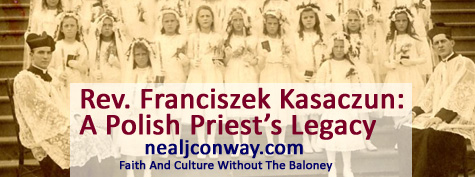 |
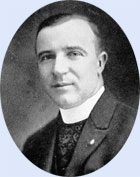 |
|---|
Rev. Franciszek Kasaczun: a Polish Priest's Legacy
April 1, 2011 (revised April 26, 2014)
| Page 1 | Page 2 | Page 3 | Page 4 |
|---|
A priority of the U.S. Catholic Church in the early 1900s was assimilating millions of immigrants into American society. Part of the strategy was the establishment of separate parishes for Irish, Poles, Italians, Germans and other ethnic groups. Hostility among the various nationalities was often a reason. The latest comers were despised, even by priests, because they were different. In the 1890s, some Polish Catholics in Northeastern PA became so fed up with being treated like dirt by a mostly-Irish clergy that they set up a schismatic Polish National Catholic Church.
The Eastern Europeans who moved in at the turn of the 19th and 20th Centuries were also unwelcome because they competed for jobs, underbidding the earlier arrivals. Worst of all, they scabbed during strikes.
In Sugar Notch, a town that never had a population of more than 2,000, there were three Catholic churches. Poles came from miles around, walking or riding trollies past the Lithuanian and Irish churches to attend Mass at Holy Family.
Counter-intuitive though it may seem to modern minds who have been taught the theory that harmony is bred by forcing different ethnic groups together so that they'll discover that they are alike--by no means a proven hypothesis--the ethnic segregation worked in assimilating the immigrants. While in all churches the Roman Catholic Mass was said in the church's universal language, Latin, the rest of parish life was conducted in the members' languages.
I think that the most thriving Catholic parish of today probably has nothing on what ethnic parishes had in the early 1900s. Through their churches, men and women off the boat from the old countries could socialize, preserve their culture, discuss their problems, mutually aid each other, learn how to get along in their new home. With no one forcefully trying to denationalize them, non-English-speaking new arrivals in the strange land could slip into American society at their own pace, as much or as little as they liked.
The immigrants' feeling of freedom to be themselves, along with the better life they found, increased their American patriotism. Their kids grew up speaking English, playing baseball and doing The Charleston. After one generation, much to the horror of the elders, including the priests, young men and women of the various ethnic groups were intermarrying.
Fr. Kasaczun, I'm told, disapproved of wedding my grandmother and her sister to men of Irish descent. Yet he performed the sacraments and his disapproval was understandable. Those one in five households amateurishly distilling their own liquor that he complained about to the Senate committee were likely not Polish. The priest's reluctance was also borne of that Polish pride, that ethno-nationalistic identity that makes the Poles and Poland unusual, if not unique.
In their new American home, the Poles of Holy Family and their pastor surely continued to remember and dream of "Poland." In the early 1910s, world events brought that dream to the threshold of reality.
Nations can emerge organically and along geographic lines. They can be artifically created. They can, like the United States, be invented by wealthy men schooled in political philosophy. The fulfillment of the dream of Poland is testimony not only to the power of ethnic identity but also to the power of art, and to the power of history as transmitted through historical legend.
Today those who propagate ideas, religious faith etc. place great confidence in rational argument, in talking heads on TV, in yakety-yak on radio. Such tongue-wagging amounts to preaching to the choir. While it may soothe the choir; it reaches few others.
It is largely forgotten that art and legend, because they work on the emotional level, reach more people, get them to pay attention more closely and implant ideas more firmly. My grandmother's formal education never continued beyond grade school, but she was very pleased when we came across Pulaski Street in Baltimore. Thanks to her girlhood Pastor Kasaczun, she knew that Pulaski and Kosciusko were Poles who had fought in The American Revolution.
Poland and "Polishness" are the creations of artists, poets and playwrights, legend-mongers, what Dr. Theodore Dalrymple called "the unacknowledged legislators of the world." Poles have long been keen on history, poetry and drama. In Poland, poetry and drama have been more popular literary forms than the novel. What is regarded as the Poland''s supreme literary achievement, Pan Tadeusz (Sir Thaddeus, 1834) by Adam Mickiewicz has been described as a novel in verse. The most famous Pole of recent decades, Karol Wojtyla/Pope John Paul II was in his youth a student of Polish letters, a poet, dramatist and actor.
Mickiewicz and other Polish intellectuals and writers of the mid-19th Century gathered the spiritual impetus for the 1910s birth of the modern Poland. These Polish romantics were caught up in the revolutionary fervor that swept across Europe in the post-Napoleonic decades. However unlike the ideological patriarchs of modern secular liberals, they did not reject religious faith, tradition and the past as horrors that must be discontinued and even wiped from memory. As kings before them had, the poets kept Poland Catholic. They even saw Poles under German and Russian domination as a messianic people whose suffering had given them lessons that they could teach the world. Expatriots were apostles. Julius Slowacki (1809-1849) even wrote of a "slavic pope."(1). Continue to Page 3.
| Page 1 | Page 2 | Page 3 | Page 4 |
|---|
(1) p. 35, Witness to Hope: The Biography of Pope John Paul II, George F. Weigel, Cliff Street Books,HarperCollins, 1999.
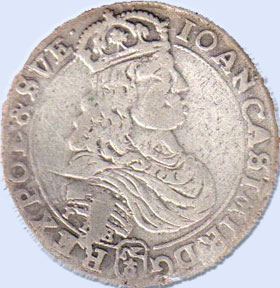 |
|---|
| The ideal of Polish Nationalists of the 19th and 20th Centuries was the Kingdom of Poland and Grand Duchy of Lithuania. This territory expanded and contracted in central Europe for almost 500 years before it was partitioned among Russia, Prussia and Austria in the 1795. Polish monarchs were elected and shared power with parliaments of nobles in a constitutionally contained commonwealth with enumerated rights, included a right to freedom of conscience.
In the face of Russia and its Eastern Orthodoxy, Poland's rulers steered their kingdom culturally in the direction of Western Roman Catholic Europe. The alphabet, although modified with accent-marked characters, is Roman, not Cyrillic. One royal family, the Jagiellons, founded and supported The Jagiellonian University of Krakow, students of which have included Nicolas Kopernik, Kazimierz Siemienowicz (perhaps the first rocket scientist) and Karol Wojtyla/Pope John Paul II. Early on, Poles developed an interest in recording historical events. My ancestors' home town of Sejny had a printing press by the 1600s. The coins shown here were issued during the 17th-Century reign of Jan II Kazimierz Waza, a priest-king of the Society of Jesus. Note that one has hammered into it the symbol of Poland; it is not a falcon but the Polish Piast Eagle. In 1655, John was on the run. Lutheran Swedes and Orthodox Russians had taken over much of his Catholic kingdom. One place that did not surrender to the Swedes, even when it was surrounded, was monastery-town of Jasna Gora. There reposes Poland's holiest relic, the icon of Our Lady of Czestochowa. Of undetermined age and origins--One legend has it as the Holy Family's table top--the icon miraculously survived a fire, wherein Mary and Jesus' flesh turned black, and bears sword marks inflicted during an attack by religious zealots. The Jasna Gora resistance inspired other Polish towns to rise up, unite and support John Casmir. On April 1, 1656, having sneaked around the Swedes to Lwow, the exiled King, at a Mass in that city's cathedral, asked Mary's protection for Poland and declared her to be Queen of his kingdom. Within a few years the Swedes and Russians were driven out. |
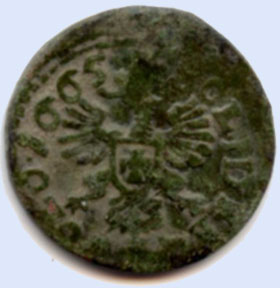 |
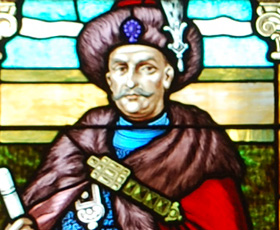 |
| Jan III Sobieski in stained glass at Holy Family. The Polish commonwealth was weak and subject to invasion and division. Sobieski served with Jan III Kasimierz Waza during "The Deluge" (Swedish/Russian invasion). A century after the Battle of Lepanto, Moslem Turks were still pressing Europe. By the time Sobieski was elected king in 1674, he was a seasoned military commander ready to take on the Ottomans. At the 1683 Battle of Vienna, Sobieski broke the Turks with a cavalry charge and was hailed as "Savior of Vienna and Western European civilization." |
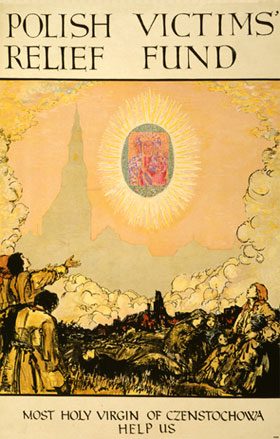 |
A Word-War-I-Era poster for Paderewski and Sienkiewicz' relief organization, invoking Our Lady of Czestochowa. |
Copyright 2011 by Neal J. Conway. All rights reserved.
About this site and Neal J. Conway
Make homepage nealjconway.com appear in this window